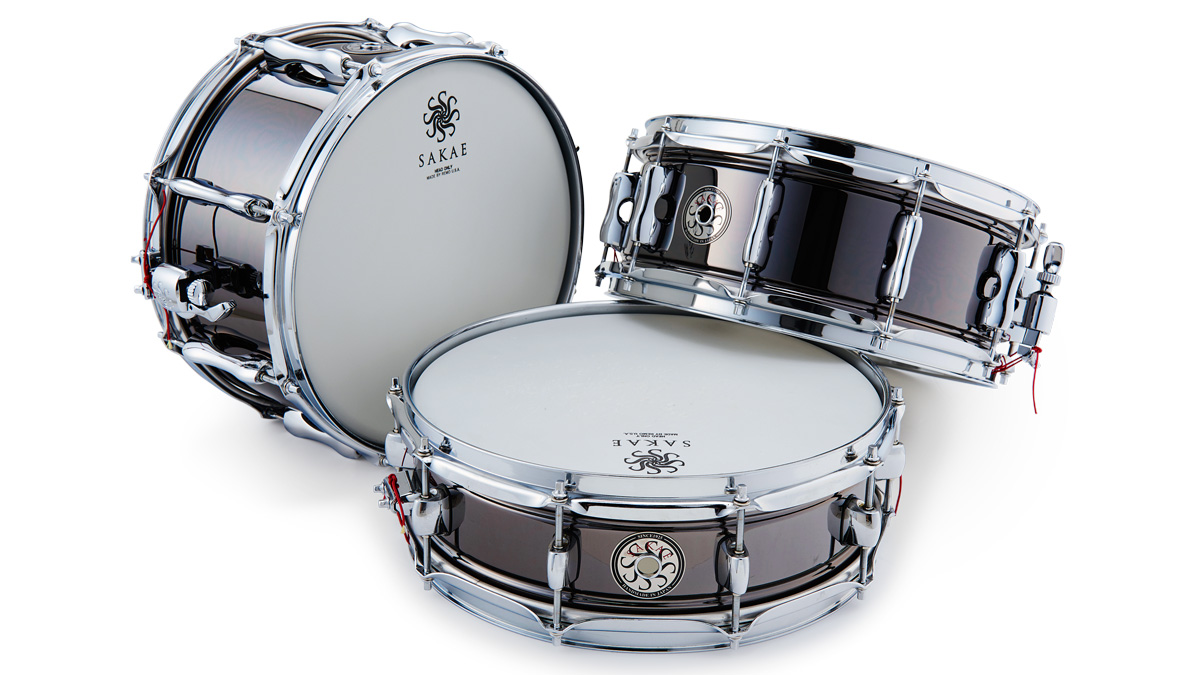MusicRadar Verdict
Great sounding, superbly made snare drums but they come with a rather hefty retail price.
Pros
- +
Simply beautiful drums.
Cons
- -
Pricey!
MusicRadar's got your back
Sakae might appear to be a newbie on the drumming scene, however this Japanese company is a third- generation family-run business and only nine years away from celebrating their Centenary year.
Now manufacturing drums in its own right, Sakae's range is steadily growing with confidence.
Build
Lined up for review are three of Sakae's shiny black nickel plating over brass snares. These include a full-bodied 14"x5.5", a piccolo- dimensioned 14"x4" and a comparatively deep 13"x6.5". Each one exudes class with a glassy black mirrored finish and chromed die-cast lugs.
While the shells of many metal snares have a single central bead, these Sakae models have two: one located under the top rim and the other just above the lower. The placement and, at a glance, appearance, is similar to those found on DW's Design Series Black Nickel Over Brass snares, however, the beads of the review drums are inverted - ie: with the 'dip' facing inwards, while the beads of the Design Series snare protrude.
Whatever design, they give strength and rigidity to the shell. Sakae says that positioning them in this way enhances vibration and allows a greater tuning range - other metal snares from Sakae also boast this feature. There are additional resonance- enhancing measures, including rim design and the span of the bridged lugs on the 14"x5.5" and the 13"x6.5". Due to the shallow physique of the 14"x4", this has single lugs, mounted shell-centre.
With the drums upturned we see the fine- detailing ends of the black-coated snare wires, with now familiar 'S' logos stamped into each of their brassy bronze ends. Looking inside for a moment, there is a single welded seam of the 1.6mm brass shell. The smooth vista of the black satin paintwork is interrupted only by two large breather holes, lug fixings and a small sticker with serial number, date of manufacture and 'Since 1925 - Handmade in Japan'.
There are currently three types of hoops offered: Righty Halo, Mighty Halo and the Clarion Halo. Made from 2.3mm thick steel, the Righty and Mighty have an extended top flange - the Clarion hoops lack this extension and are made from 1.3mm steel.
Righty Halos have an outward facing top flange - as on the review models. However, the Mighty Halo has an inward facing top flange, in a similar design to the 'stick saver' hoops from Slingerland.
Hands On
All of the drums have arrived with the heads slackened off - not the usual pre-stretched, 'crank 'em up' type of tension we often witness out of the factories. As we begin tensioning, we make a quick mental note of just how smoothly the components operate. With the pitch about the same at each lug point, there's the process of fine-tuning. This involves listening to both the pitch and head harmonics, tapping lightly at the edge of the heads and tweaking where necessary.
To detect any pitch differences over on the snare heads (avoiding wire rattle), we use a stick to temporarily elevate them away from the surface of the head - sliding the stick under the wires. Once the heads feel taut, without choking the snare wires, it's the turn of the batters which are tightened and tuned to a similar pitch.
There's also an underlying lush fat snare sound which really has the mouth watering.
The usual tentative strikes upon each drum give more than just a hint of what kind of treat your ears might be offered by these brass beauties. Striking with enthusiasm, it's hard to stray from the 13" - this has a surprising amount of guts for such a little fella. You can actually feel its power through your body - wise to avoid getting too close for fear of shaking any teeth out!
It's not all about power though, there's also an underlying lush fat snare sound which really has the mouth watering.
When it comes to sensitivity and controllability, as expected, the 4"-deep snare appears to have an edge on the others . The slightest touch has the snare reacting instantly in sympathy - does this make it more adept when it comes to subtlety? We'll see - however, it doesn't take long to realise it's much the same story with the other two drums. Here we have the sound, sensitivity, subtlety and power - a great combo!
Cross-sticking produces a tasty bone-dry 'nutty' sound which could be required for those quieter, laid-back pieces. When it comes time for a 'lift', a good wallop of a 5B shoulder against the head and rim not only produces a wholly satisfying woody snare sound, but (if we pause sticking for a moment) we hear a long-lasting and pleasant overtone.
When building from delicate buzz rolls to full-on double strokes (with the occasional rim-shot thrown in for good measure), such is the sound and control, you can't help feeling rather smug.
With each drum tensioned fairly low there is a huge amount of oomph (even from the 14"x4"), however, taken up perhaps to the limits of the tension rods they provide us with an immense whip-cracking sound - slicing and biting through thunderously loud music. Then, back again with gentle strokes, a delicate tickle once again shows the subtle side of these superb brass shells.

“The screaming was deafening!”: How a Japanese tour transformed the career of a weird little band known as the ‘Beatles of hard rock’

Ranked: Moog’s semi-modular ‘Mother’ synths from worst to best

“If it wasn’t for that song, that would have been the end of the band”: How one track’s sudden gear-switch led Coldplay into their imperial phase










